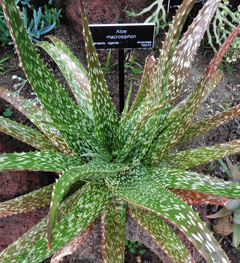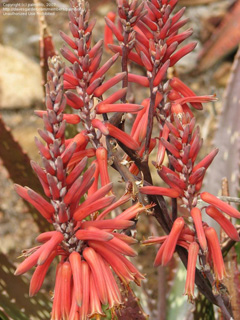 |
|
Copyright Ken Blackford. Huntington Botanic Gardens |
 |
|
Translate this page:
Summary
Aloe macrosiphon.
Found in Eastern tropical Africa, Aloe macrosiphon is stemless, perennial, succulent, evergreen plant with rosette leaves. It forms suckers, often freely, and can form large clumps. It is used as a medicinal plant for treatment for various skin conditions such as wounds and burns, haemorrhoids, sore throat, and coughs. It is also often used as laxative in small doses because if used in excess it may cause congestion and irritation of the pelvic organs.
Physical Characteristics

 Aloe macrosiphon is an evergreen Perennial growing to 0.5 m (1ft 8in) by 0.5 m (1ft 8in) at a slow rate.
Aloe macrosiphon is an evergreen Perennial growing to 0.5 m (1ft 8in) by 0.5 m (1ft 8in) at a slow rate.
See above for USDA hardiness. It is hardy to UK zone 10.
Suitable for: light (sandy) and medium (loamy) soils, prefers well-drained soil and can grow in nutritionally poor soil. Suitable pH: mildly acid, neutral and basic (mildly alkaline) soils. It can grow in semi-shade (light woodland) or no shade. It prefers dry soil and can tolerate drought.
UK Hardiness Map
US Hardiness Map
Synonyms
Aloe compacta Reynolds Aloe mwanzana Christian
Plant Habitats
Edible Uses
References More on Edible Uses
Medicinal Uses
Plants For A Future can not take any responsibility for any adverse effects from the use of plants. Always seek advice from a professional before using a plant medicinally.
Antiasthmatic Antihaemorrhoidal Antirheumatic Antispasmodic Bitter Digestive Dysentery Kidney
Kidney Laxative Purgative Refrigerant Skin Vermifuge
The distinctive constituents in Aloe leaves are phenolic compounds, including chromone, anthraquinone or anthrone derivatives. Some of the compounds are found in many species, whereas others occur in only a few[ 299 ]. This species has very similar properties to Aloe vera[ 299 ]. The uses of Aloe vera are as follows:- The clear gel contained within the leaf makes an excellent treatment for wounds, burns and a host of other skin disorders, placing a protective coat over the affected area, speeding up the rate of healing and reducing the risk of infection. The gel is also applied externally to cure haemorrhoids[ 254 , 299 , K ]. These actions are in part due to the presence of aloectin B, which stimulates the immune system[ 254 ]. To obtain this gel, the leaves can be cut in half along their length and the inner pulp rubbed over the affected area of skin[ K ]. This has an immediate soothing effect on all sorts of burns and other skin problems[ K ]. The use of the gel has been approved in the United States for the treatment of leukaemia in cats, of fibrosarcoma in dogs, for wound healing in humans and to prevent dry socket in humans[ 299 ]. The peeled leaves are eaten to relieve sore throat and coughs and as a mild laxative. As a food supplement, the leaf gel is said to facilitate digestion, and to improve blood and lymphatic circulation, as well as kidney, liver and gall bladder functions[ 299 ]. There are claims of beneficial activity of Aloe vera products in cases of AIDS, arthritis, or other chronic and debilitating conditions. However, these claims have not been substantiated by scientific studies. There is also no evidence that topical Aloe vera gel is effective in preventing or minimizing radiation-induced skin reactions in cancer patients. In large amounts, the gel has anti-irritant properties[ 299 ]. A bitter substance is obtained from the yellow sap at the base of the leaf. Known as 'bitter aloes', it contains anthraquinones which are a useful digestive stimulant and a strong laxative[ 254 ]. It also has vermicidal properties[ 299 ]. It is taken internally in the treatment of chronic constipation, poor appetite, digestive problems etc[ 238 ]. Mixed with other ingredients to mask its bitter taste, it is taken against asthma and to treat coughs. Similar mixtures are taken to cure dysentery, kidney problems or against dyspepsia[ 299 ]. It should be administered preferably in combination with an antispasmodic to moderate its griping action[ 299 ]. It is applied externally as a refrigerant to treat acne or cuts[ 299 ]. 'Cura'ao aloe' should contain at least 28% hydroxy-anthraquinone derivatives; it is almost entirely soluble in 60% alcohol and for more than 70% in water. It should not contain more than 12% moisture and 3% ash[ 299 ]. The plant is strongly purgative so great care should be taken over the dosage[ 238 ]. Anthraquinone-based laxatives, such as bitter aloes, should not be used longer than 8 - 10 days, nor by children younger than 12 years. Contra-indications include pregnancy, breastfeeding, intestinal inflammations and haemorrhoids[ 238 , 243 , 299 ]. When plants are grown in pots the anthraquinone content is greatly reduced[ 254 ].
References More on Medicinal Uses
The Bookshop: Edible Plant Books
Our Latest books on Perennial Plants For Food Forests and Permaculture Gardens in paperback or digital formats.

Edible Tropical Plants
Food Forest Plants for Hotter Conditions: 250+ Plants For Tropical Food Forests & Permaculture Gardens.
More

Edible Temperate Plants
Plants for Your Food Forest: 500 Plants for Temperate Food Forests & Permaculture Gardens.
More

More Books
PFAF have eight books available in paperback and digital formats. Browse the shop for more information.
Shop Now
Other Uses
Other uses rating: Low (1/5). Suitable for xeriscaping. Suitable for growing in containers.
Special Uses
References More on Other Uses
Cultivation details
The plant is reported to hybridize in the wild with Aloe secundiflora[ 328 ]. Aloe species follow the Crassulacean acid metabolism (CAM). CAM plants can fix carbon dioxide at night and photosynthesize with closed stomata during the day, thus minimizing water loss. This, plus their succulent leaves and stems, and the presence of a thick cuticle, makes them well adapted to dry conditions[ 299 ].
References Carbon Farming Information and Carbon Sequestration Information
Temperature Converter
Type a value in the Celsius field to convert the value to Fahrenheit:
Fahrenheit:
The PFAF Bookshop
Plants For A Future have a number of books available in paperback and digital form. Book titles include Edible Plants, Edible Perennials, Edible Trees,Edible Shrubs, Woodland Gardening, and Temperate Food Forest Plants. Our new book is Food Forest Plants For Hotter Conditions (Tropical and Sub-Tropical).
Shop Now
Plant Propagation
Seed - we have no specific information on this species - in general Aloes are sown in a sandy, well-drained potting soil in a warm, shady position in standard seed trays. Germination takes about three weeks. Cover the seed with a thin layer of sand (1 - 2mm), keep moist. The seedlings can be planted out in individual bags or containers as soon as they are large enough to handle[ 295 ].
Other Names
If available other names are mentioned here
Tanzanian Aloe
Native Range
Coming Soon
Weed Potential
Right plant wrong place. We are currently updating this section.
Please note that a plant may be invasive in one area but may not in your area so it's worth checking.
None Known
Conservation Status
IUCN Red List of Threatened Plants Status : This taxon has not yet been assessed.

| Related Plants
|
| Latin Name | Common Name | Habit | Height | Hardiness | Growth | Soil | Shade | Moisture | Edible | Medicinal | Other |
| Aloe arborescens | Candelabra Aloe, Tree Aloe, Mountain Bush Aloe | Shrub | 3.0 |
10-11
| M | LM | SN | DM | 2 | 5 | 3 |
| Aloe camperi | Aloe | Shrub | 0.8 |
9-12
| M | LM | SN | D | 0 | 4 | 1 |
| Aloe ferox | Cape Aloe, Bitter Aloe, Red Aloe, Cape Aloe, Alligator Jaw Aloe | Shrub | 3.0 |
9-11
| S | LM | N | D | 2 | 5 | 3 |
| Aloe maculata | Soap Aloe | Perennial | 0.6 |
8-12
| M | LMH | SN | DM | 2 | 2 | 2 |
| Aloe marlothii | Mountain Aloe | Perennial | 3.0 |
9-11
| M | LMH | N | DM | 2 | 3 | 3 |
| Aloe perryi | Perry's Aloe | Perennial | 0.3 |
10-12
| S | LM | N | D | 0 | 4 | 2 |
| Aloe vera | Aloe Vera, Barbados aloe, First Aid Plant, Medicinal Aloe | Perennial | 0.8 |
9-11
| S | LM | N | DM | 1 | 5 | 3 |
| Aquilaria malaccensis | Agar Wood, Eaglewood, Indian Aloewood, Aloeswood | Tree | 20.0 |
10-12
| S | LMH | SN | M | 1 | 3 | 3 |
| Hesperaloe funifera | New Mexico false yucca | Perennial | 1.8 |
6-9
| S | LM | N | DM | 0 | 0 | 2 |
| Hesperaloe nocturna | | Perennial | 1.8 |
6-9
| S | LM | N | DM | 0 | 0 | 2 |
| Yucca aloifolia | Spanish Bayonet, Aloe yucca, Dagger Plant, Yucca, Spanish Bayonet | Tree | 7.5 |
8-10
| S | LMH | SN | DM | 3 | 1 | 2 |
|
Growth: S = slow M = medium F = fast. Soil: L = light (sandy) M = medium H = heavy (clay). pH: A = acid N = neutral B = basic (alkaline). Shade: F = full shade S = semi-shade N = no shade. Moisture: D = dry M = Moist We = wet Wa = water.
Now available:
Food Forest Plants for Mediterranean Conditions
350+ Perennial Plants For Mediterranean and Drier Food Forests and Permaculture Gardens.
[Paperback and eBook]
This is the third in Plants For A Future's series of plant guides for food forests tailored to
specific climate zones. Following volumes on temperate and tropical ecosystems, this book focuses
on species suited to Mediterranean conditions—regions with hot, dry summers and cool, wet winters,
often facing the added challenge of climate change.
Read More
Expert comment
Author
Baker
Botanical References
1
Links / References
For a list of references used on this page please go here
A special thanks to Ken Fern for some of the information used on this page.
Readers comment
| Add a comment |
|
If you have important information about this plant that may help other users please add a comment or link below. Only comments or links that are felt to be directly relevant to a plant will be included. If you think a comment/link or information contained on this page is inaccurate or misleading we would welcome your feedback at [email protected]. If you have questions about a plant please use the Forum on this website as we do not have the resources to answer questions ourselves.
* Please note: the comments by website users are not necessarily those held by PFAF and may give misleading or inaccurate information.
To leave a comment please Register or login here All comments need to be approved so will not appear immediately.
|
Subject : Aloe macrosiphon
|
|
|
|